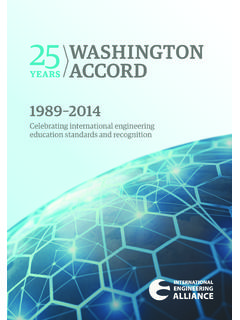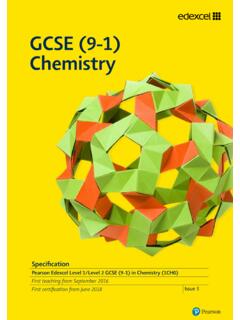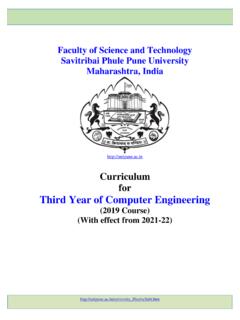Transcription of Graduate Attributes and Professional Competencies
1 Constituent Agreements Washington Accord International Professional Engineers Agreement Sydney Accord International Engineering Technologists Agreement Dublin Accord APEC Engineer Agreement Graduate Attributes and Professional Competencies Version 3: 21 June 2013. This document is available through the IEA website: Executive Summary Several accrediting bodies for engineering qualifications have developed outcomes- based criteria for evaluating programmes. Similarly, a number of engineering regulatory bodies have developed or are in the process of developing competency- based standards for registration.
2 Educational and Professional accords for mutual recognition of qualifications and registration have developed statements of Graduate Attributes and Professional competency profiles. This document presents the background to these developments, their purpose and the methodology and limitations of the statements. After defining general range statements that allow the Competencies of the different categories to be distinguished, the paper presents the Graduate Attributes and Professional competency profiles for three Professional tracks: engineer, engineering technologist and engineering technician.
3 1 Introduction Engineering is an activity that is essential to meeting the needs of people, economic development and the provision of services to society. Engineering involves the purposeful application of mathematical and natural sciences and a body of engineering knowledge, technology and techniques. Engineering seeks to produce solutions whose effects are predicted to the greatest degree possible in often uncertain contexts. While bringing benefits, engineering activity has potential adverse consequences. Engineering therefore must be carried out responsibly and ethically, use available resources efficiently, be economic, safeguard health and safety, be environmentally sound and sustainable and generally manage risks throughout the entire lifecycle of a system.
4 Typical engineering activity requires several roles including those of the engineer, engineering technologist and engineering technician, recognized as Professional registration categories in many jurisdictions1. These roles are defined by their distinctive Competencies and their level of responsibility to the public. There is a degree of overlap between roles. The distinctive Competencies , together with their educational underpinnings, are defined in sections 4 to 6 of this document. The development of an engineering Professional in any of the categories is an ongoing process with important identified stages.
5 The first stage is the attainment of an accredited educational qualification, the Graduate stage. The fundamental purpose of engineering education is to build a 1. The terminology used in this document uses the term engineering as an activity in a broad sense and engineer as shorthand for the various types of Professional and chartered engineer. It is recognized that engineers, engineering technologists and engineering technicians may have specific titles or designations and differing legal empowerment or restrictions within individual jurisdictions.
6 IEA Graduate Attributes and Professional Competency Profiles Page 1 of 16. knowledge base and Attributes to enable the Graduate to continue learning and to proceed to formative development that will develop the Competencies required for independent practice. The second stage, following after a period of formative development, is Professional registration. The fundamental purpose of formative development is to build on the educational base to develop the Competencies required for independent practice in which the Graduate works with engineering practitioners and progresses from an assisting role to taking more individual and team responsibility until competence can be demonstrated at the level required for registration.
7 Once registered, the practitioner must maintain and expand competence. For engineers and engineering technologists, a third milestone is to qualify for the international register held by the various jurisdictions. In addition, engineers, technologists and technicians are expected to maintain and enhance competency throughout their working lives. Several international accords provide for recognition of graduates of accredited programmes of each signatory by the remaining signatories. The Washington Accord (WA) provides for mutual recognition of programmes accredited for the engineer track.
8 The Sydney Accord (SA) establishes mutual recognition of accredited qualifications for engineering technologist. The Dublin Accord (DA). provides for mutual recognition of accredited qualifications for engineering technicians. These accords are based on the principle of substantial equivalence rather than exact correspondence of content and outcomes. This document records the signatories' consensus on the Attributes of graduates for each accord. Similarly, the International Professional Engineers Agreement2 (IPEA) and the International Engineering Technologists Agreement3 (IETA) provide mechanisms to support the recognition of a Professional registered in one signatory jurisdiction obtaining recognition in another.
9 The signatories have formulated consensus competency profiles for the registration and these are recorded in this document. While no competence forum currently exists for technicians, competency statements were also formulated for completeness and to facilitate any future development. Section 2 give the background to the Graduate Attributes presented in section 5. Section 3 provides background to the Professional competency profiles presented in section 6. General range statements are presented in section 4. The Graduate Attributes are presented in section 5 while the Professional competency profiles are defined in section 6.
10 Appendix A defines terms used in this document. Appendix B sketches the origin and development history of the Graduate Attributes and Professional competency profiles. 2 Graduate Attributes Purpose of Graduate Attributes Graduate Attributes form a set of individually assessable outcomes that are the components indicative of the Graduate 's potential to acquire competence to practise at the appropriate level. The Graduate Attributes are exemplars of the Attributes expected of Graduate from an accredited programme. Graduate Attributes are clear, succinct statements of the expected capability, qualified if necessary by a range indication appropriate to the type of programme.





